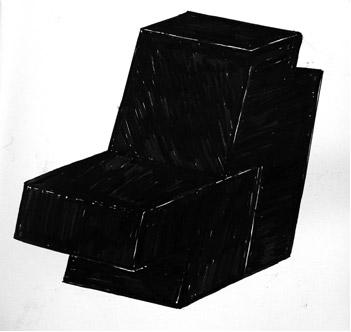
Oscar Tuazon, "Two-part Chair," 2012. Ink on paper.
Fondazione Giuliani per l'arte contemporanea
Scott Burton by Oscar Tuazon
with Scott Burton, Beau Dick, Peter Fend, Jackie Ferrara, Martino Gamper, Bruce Goff, Elias Hansen , Bea Schlingelhoff, Oscar Tuazon
21 April–21 July 2012
Opening:
Friday, 20 April 2012, 6–10pm
Fondazione Giuliani per l'arte contemporanea
Via Gustavo Bianchi
1 – 00153 Rome Italy
www.fondazionegiuliani.org
Scott Burton
by Oscar Tuazon
"The base, or pedestal, is a specialized form of table."
—Scott Burton
I called the show "Scott Burton" because I had to put a name on how I feel. Probably it would have made more sense to take the title from Bea Schlingelhoff, and call it "Fuck The Participant", a pun that would have described more accurately the dual nature of Burton's work, subtly perverse, antagonistic, sexy. There's a great self-portrait of Burton, posing in Afro wig and white face, wearing overalls and an enormous dildo, that could very well be subtitled Fuck the Participant.
I guess I tried to become Scott Burton. I don't know how other people do it, but that's how I do it. Which was strange. A demon came into my head. Suddenly I was alone inside that demon's house. I tried to build pedestals, I tried to build tables. I thought very literally about becoming another person, I was wearing a Beau Dick mask. Dick makes masks in the Kwakiutl ceremonial tradition, objects designed to serve a function—but an idea of function expanded to include hallucinatory states and dreams. Call it psychic utility, I don't know what to call it but I know what it does. I'm sure that Dick tries on the masks while he makes them, the way Martino Gamper tests the feel of a chair, by occupying it, testing it out with his body. Which is something you can't say about painting. Bea said "painting as a medium might be inherently suspect," and I tend to agree with her.
The renderings of Bruce Goff, the original outlaw architect, are closer to science fiction illustration than to traditional architecture. You can imagine Goff, in silk pajamas, building crystal fractal staircases in his mind, unearthing the orb, gilding the entire portal, inside and out. Elias and I tried that too, it was bad. Jackie Ferrara has taken a more systematic approach, rigorous and lean, a self-replicating program. Ferrara, one of the few artists to have ventured into the dangerous zone between sculpture and furniture prior to Burton, is known primarily for three-dimensional works. The extensive selection of drawings and photographs included in the exhibition, though they span the period from 1981–2007, display a remarkable consistency. Unpretentious and plain, the drawings have a rare didactic clarity—reading them is an almost physical experience.
Scott Burton was invited to do the seating for the MIT art gallery while the building was still being designed and he spent a lot of time going over the plans with the architect, I.M. Pei, finally fixating on a particular feature of the building. Burton's proposal, of a stone bench in the lobby of the space, incorporated the hand railing of the building's mezzanine as the backrest for the bench, quietly disappearing into the architecture of the building. Or, looked at another way, Burton's proposal perverts the proscribed function of the space, opening a zone of confusion at the center of the building. I think that's called topping from the bottom. Of course this radical gesture was actually illegal, contravening the building code for handrail height and use. The proposal was deemed too dangerous to build, and Burton moved on, developing the initial idea into an elegant and restrained bench, following the curve of the handrail from a distance, disappearing again.
Burton's work is characterized by invisibility—perversely banal, inconspicuous, ugly, painful on the genitals, masochistic—and a kind of brutal self-recognition, painful realism. Brancusi came up with a name, 'pragmatic sculpture' that Burton liked to use, but Burton was a lot harder on himself than Brancusi ever was. Whereas Burton was a true nihilist, Peter Fend remains, for some unknown reason, an incurable optimist, the only person I can think of who still believes, fervently, in the revolutionary potential of an artwork to transform the world. What they share, apart from a masochistic love of failure, is a visionary and inspiring ideal of art as invisible, ubiquitous, elemental. Alive in the world. And, like Ferrara's drawings, resolutely partial, incomplete—instructions awaiting action.
The thing about a chair is that when you're using it you aren't looking at it. Can a sculpture of a chair can also be a chair, can a thing can have a dual identity, be doubled, transsexualized, why can't a thing can be two things?
Oscar Tuazon (b. 1975, Seattle, USA) lives and works in Paris. Recent solo shows include Galerie BaliceHertling, Paris (with Elias Hansen, upcoming); Manual Labor, Galerie Eva Presenhuber, Zurich (2012); Die, The Power Station, Dallas (2011); STEEL, PRESSURE-TREATED WOOD, OAK POST, OFFICE CHAIR, INDUCTION STOVETOP, ALUMINUM, Standard (Oslo), Oslo (2011); America Is My Woman, Maccarone, New York, USA (2011); My Mistake, ICA – Institute of Contemporary Art, London (2010); Oscar Tuazon, Kunsthalle Bern, Switzerland (2010). Selected group exhibitions include Whitney Biennial 2012, Whitney Museum of American Art, New York (2012); The Language of Less, Museum of Contemporary Art, Chicago (2011); ILLUMInations (curated by Bice Curiger), 54th International Art Exhibition – La Biennale di Venezia, Venice (2011).
Fondazione Giuliani per l'arte contemporanea
via Gustavo Bianchi, 1 – 00153 Rome Italy
Tuesday through Saturday from 3:00pm to 7:30pm, and by appointment
www.fondazionegiuliani.org -
info@fondazionegiuliani.org - +39 06.57301091
Press contact: Elena Bari | NewRelease – info@newrelease.it - +39 3289781241


